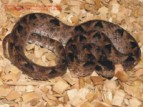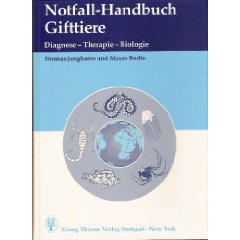|







| |
Calloselasma rhodostoma






Namen: Malayische
Mokassinschlange, Malaiische Mokassin-Grubenotter; Malayan Pit Viper;
Lokale Namen:
Ulah Kapak Bodoh, Ularkapak Daun, Ular Tanah, Ular Biludak, Ular Gebuk,
Ular Bandotan Bedor, Ngu Kapa, Ngu Kaba, Ngu Maaw-sao, Oraj Lemah
Unterarten und Vorkommen:
- Calloselasma rhodostoma rhodostoma
- Calloselasma rhodostoma annamensis
- Südost-Kambodscha, Vietnam
Alte Namen:
- Trigonocephalus rhodostoma
- Leiolepis rhodostoma
- Agkistrodon rhodostoma
- Ancistrodon annamensis
- Ancistrodon rhodostoma
- Agkistrodon annamensis
- Calloselasma annamensis
Vorkommen: Süd-Vietnam, Kambodscha, Thailand, Laos,
West-Malaysia, Indonesien (Java)
Beschreibung:
Die nachtaktiven Tiere werden bis zu einem Meter lang. Der Kopf grenzt sich
deutlich vom Körper ab. Die Tiere haben eine graue bis braune Färbung mit
dunkleren Rauten oder Dreiecken. Meist sind die Tiere im Flachland, dort vor
allem in Gummiplantagen, zu finden. Sie bevorzugen als Lebensraum feuchte
Gebiete und sind während der Zeit des Monsuns am aktivsten. In den trockenen
Zeiten dringen die Tiere auch in die Wohnungen ein. Die Tiere beißen bei einer
Bedrohung oder Reizung heftig und wiederholt zu.
Toxine: Es sind Fibrogenasen
gefunden worden. Die Toxine wirken vor allem auf die Blutgerinnung, können aber
auch Nekrosen verursachen.
Symptome:
Die Tiere verursachen die meisten Schlangenbisse im Südosten Asiens, verursachen
aber wenige Todesfälle. Trotz allem muss jeder Biss durch die Schlange als
potentiell lebensgefährlich eingeschätzt werden.Der Großteil der Bisse erfolgt entweder bei der Arbeit
in den Gummiplantagen oder im Bereich um und in der Wohnung. Oft finden sich als
Langzeitfolge Nekrosen, die häufig Funktionseinschränkungen bis zum
Funktionsverlust einzelner Gliedmaßen verursachen. Ohne Antiveningabe liegt die Sterblichkeit bei 1 - 2 %. Lokale zum Teil ausgedehnte Schwellungen,
lokale Schmerzen, Nekrosen, zum Teil stark ausgedehnte Blasenbildung,
Blutgerinnungsstörungen bis zur Ungerinnbarkeit (schon 30 Minuten nach dem Biss)
des Blutes, anhaltende Sickerblutung aus der Bissstelle, Hämatemesis, Hämaturie,
intrazerebrale Blutung (selten), Schock, Fieber. Allgemeine Anzeichen sind
Kopfschmerzen, Übelkeit, Erbrechen, Durchfall, abdominelle Schmerzen, Schwindel
und Kreislaufstörungen bis zum Kollaps.
Fallbeschreibung:
Die Wirkung eines Bisses sehen Sie nach dem Klick.
Maßnahmen:
Die pressure-immobilization-Methode darf nicht
angewendet werden. Diese Maßnahme kann schwere Folgeschäden nach sich ziehen.
Die betroffene Stelle ist ruhig zustellen. Der Patient muss liegend in eine
Klinik transportiert werden. Die weiteren Maßnahmen bis zur Klinik erfolgen
symptomatisch. Es existiert ein Antivenin. Meist ist es aber nicht notwendig das
Antivenin zu verabreichen. Es sollte nur nach Rücksprache mit einer
Giftnotrufzentrale erfolgen.
Literatur:
-

-
The Reptile Database
-
WCH Clinical Toxinology
-
The effect of different snake venoms and anti-venoms on thrombin clotting time
in human plasma.
-
Anti-necrosis potential of polyphenols against snake venoms.
-
Pig as an experimental model for the study of snake venom induced local tissue
necrosis.
-
Neutralization of lethality and proteolytic activities of Malayan pit viper
(Calloselasma rhodostoma) venom with North American Virginia opossum (Didelphis
virginiana) serum.
-
Induction of apoptosis in yeast by L-amino acid oxidase from the Malayan pit
viper Calloselasma rhodostoma.
-
Abruptio placentae and fetal death following a Malayan pit viper bite.
-
Structural and functional characterization of myotoxin, Cr-IV 1, a
phospholipase A2 D49 from the venom of the snake Calloselasma rhodostoma.
-
Molecular cloning, expression and purification of L-amino acid oxidase from
the Malayan pit viper Calloselasma rhodostoma.
-
Structural and functional properties of Cr 5, a new Lys49 phospholipase A2
homologue isolated from the venom of the snake Calloselasma rhodostoma.
-
Crystal structure of LAAO from Calloselasma rhodostoma with an L-phenylalanine
substrate- insights into structure and mechanism.
-
A study of 225 Malayan pit viper bites in Thailand.
-
Hyaluronidase inhibitors (sodium cromoglycate and sodium auro-thiomalate)
reduce the local tissue damage and prolong the survival time of mice injected
with Naja kaouthia and Calloselasma rhodostoma venoms.
-
Purification and characterization of a variant of rhodocetin from Calloselasma
rhodostoma (Malayan pit viper) venom.
-
A novel dimer of a C-type lectin-like heterodimer from the venom of
Calloselasma rhodostoma (Malayan pit viper).
-
Structure and characterization of the glycan moiety of L-amino-acid oxidase
from the Malayan pit viper Calloselasma rhodostoma.
-
Differential expression and geographic variation of the venom phospholipases
A2 of Calloselasma rhodostoma and Trimeresurus mucrosquamatus.
-
Aggretin, a heterodimeric C-type lectin from Calloselasma rhodostoma (malayan
pit viper), stimulates platelets by binding to alpha 2beta 1 integrin and
glycoprotein Ib, activating Syk and phospholipase Cgamma 2, but does not
involve the glycoprotein VI/Fc receptor gamma chain collagen receptor.
-
L-amino-acid oxidase from the Malayan pit viper Calloselasma rhodostoma.
Comparative sequence analysis and characterization of active and inactive
forms of the enzyme.
-
Rhodocetin, a novel platelet aggregation inhibitor from the venom of
Calloselasma rhodostoma (Malayan pit viper)- synergistic and noncovalent
interaction between its subunits.
-
Venomous snakebite in Thailand. I- Medically important snakes.
-
Proteolytic specificity of rhodostoxin, the major hemorrhagin of Calloselasma
rhodostoma (Malayan pit viper) venom.
-
Structural studies of a major hemorrhagin (rhodostoxin) from the venom of
Calloselasma rhodostoma (Malayan pit viper).
-
Electrophoretic profiles and biological activities- intraspecific variation in
the venom of the Malayan pit viper (Calloselasma rhodostoma)
-
Action of Calloselasma rhodostoma (Malayan pit viper) venom on human blood
coagulation and fibrinolysis using computerized thromboelastography (CTEG).
-
An investigation on the antigenic cross-reactivity of Calloselasma rhodostoma
(Malayan pit viper) venom hemorrhagin, thrombin-like enzyme and L-amino acid
oxidase using enzyme-linked immunosorbent assay.
-
Purification and properties of the L-amino acid oxidase from Malayan pit viper
(Calloselasma rhodostoma) venom.
-
Calloselasma rhodostoma, Malayen- Mokassinotter
-
Malayische
Mokassinotter – Wikipedia
-
Calloselasma rhodostoma
|